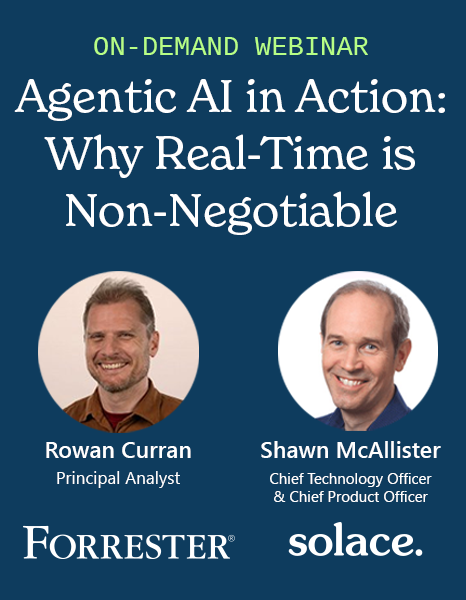Home > Blog > Artificial Intelligence
Subscribe to Our Blog
Get the latest trends, solutions, and insights into the event-driven future every week.
Thanks for subscribing.
In today’s fast paced world generic, stale AI answers no longer cut it, so enterprises are racing to put in place the infrastructure it takes to power smarter, faster, and more contextual interactions. From resolving support tickets to guiding product decisions, success now depends on AI systems’ ability to stay in sync with the pulse of the business — accessing live knowledge via retrieval-augmented generation (RAG) without sacrificing trust, scalability, or control. That’s why we’re excited to announce the beta releases of Solace Standalone RAG Agent and Solace Micro-Integration for Qdrant. Together these products represent a step forward in enabling real-time, context-aware AI across the enterprise
New RAG Agent
Built to work with micro-integrations and vector databases, Standalone RAG Agent brings RAG to life so can unlock faster, smarter, and more scalable AI-powered interactions.
Standalone RAG Agent acts as a smart processor that connects your AI models directly to live enterprise knowledge. When a query event is received from a customer portal, chatbot, or application, the agent performs a semantic search across a vector database populated by micro-integrations. It retrieves the most relevant pieces of enterprise data, sends the query and context to a configured large language model (LLM), and returns a grounded, AI-generated response via the event mesh. This all happens in real time so users and downstream applications always receive the latest information.
Standalone RAG Agent meets enterprise demands in the following ways:
- Capacity and Resilience: It handles concurrent queries with low latency, automatically manages back-pressure during load spikes, and guarantees message delivery — all essential requirements for mission-critical AI applications.
- Observability: It supports full traceability across the RAG workflow, allowing enterprises to monitor and audit vector database queries, LLM interactions, and the delivery of responses to downstream applications. This level of observability is crucial for organizations that must comply with strict data privacy regulations or need to closely monitor LLM API usage to manage costs.
- No Lock-In: It supports OpenAI-compatible models and a wide range of vector databases so enterprises can build a tailored AI ecosystem without locking themselves into a single vendor or architecture.
The initial beta release focuses on key use cases such as:
- Customer service knowledge bases
- Real-time product information delivery
- Technical support automation
In each of these scenarios, the agent acts as a critical bridge, bringing live enterprise knowledge into AI responses to improve accuracy, boost operational efficiency, and enhance the overall customer experience. Whether it’s suggesting solutions to a new support ticket or answering a customer’s product question in real time, the agent ensures that AI interactions are powered by the latest information available — not outdated, static datasets.
My colleague Matt Mays recorded this demonstration showing how it works:

New Qdrant Micro-Integration
To support this architecture, we’re also introducing Solace Micro-Integration for Qdrant — a lightweight, cloud-managed connector that streams events from your event mesh into the Qdrant vector database. This micro-integration transforms event data into vector embeddings and indexes them in Qdrant collections, ensuring your AI systems always have access to the freshest contextual data.
It features configurable embedding generation, automatic collection management, and is designed specifically for RAG use cases like semantic search and recommendation engines.
By eliminating the need for custom code, it dramatically simplifies the integration between your event-driven architecture and vector database infrastructure — and pairs perfectly with the Standalone RAG Agent for a complete, production-ready RAG pipeline.
This means that businesses can:
- Dramatically improve customer satisfaction by providing faster, more consistent answers.
- Spend less time searching for information and more time focusing on complex cases that require human expertise.
- Access real-time updates to documentation, product catalogs, and service information, eliminating the delays associated with manual updates or batch processing.
- Ensure that multiple systems can subscribe to and consume AI-generated responses independently via an event-driven design, making it easier to scale AI capabilities across multiple departments without creating new silos.
Conclusion
As enterprises move beyond experimentation into the realm of operationalizing AI at scale, reliable, real-time RAG becomes a competitive advantage. Solace Standalone RAG Agent and Solace Micro-Integration for Qdrant help organizations not only meet today’s demands for smarter, faster AI, but future-proof their architecture for the evolving AI landscape.
If you’re ready to deliver more accurate, context-rich AI experiences powered by real-time enterprise data, check them out and start building the next generation of intelligent applications today.
Agentic AI in Action:Why Real-Time Is Non-NegotiableOn-demand webinar featuring agentic AI case studies and expert analysis from Forrester.Watch the Webinar

Explore other posts from category: Artificial Intelligence

Anna is a senior product marketing manager at Solace, with over 15 years of experience in enterprise software, driving product adoption and market penetration for integration and API management products. She loves crafting messaging and compelling narratives that build brand authority. With a passion for innovation, Anna enjoys collaborating with cross-functional teams to successfully launch campaigns that enhance product visibility and drive revenue growth – all while helping organizations navigate the complexities of digital transformation.

Matt Mays is principal product manager for integrations at Solace where he is turning integration inside out by moving micro-integrations to the edge of event-driven systems. Previously, Matt worked as senior product manager at SnapLogic where he led several platform initiatives around security, resiliency and developer experience. Before that, Matt was senior product manager at Amadeus IT Group, where he launched MetaConnect, a cloud-native travel affiliate network SaaS that grew to serve over 100 airlines and metasearch companies.
Matt holds an MFA from San Jose State University's CADRE Laboratory for New Media and a BA from Vanderbilt University. When not working on product strategy, Matt likes to explore generative art, AR/VR, and creative coding.


Subscribe to Our Blog
Get the latest trends, solutions, and insights into the event-driven future every week.
Thanks for subscribing.
